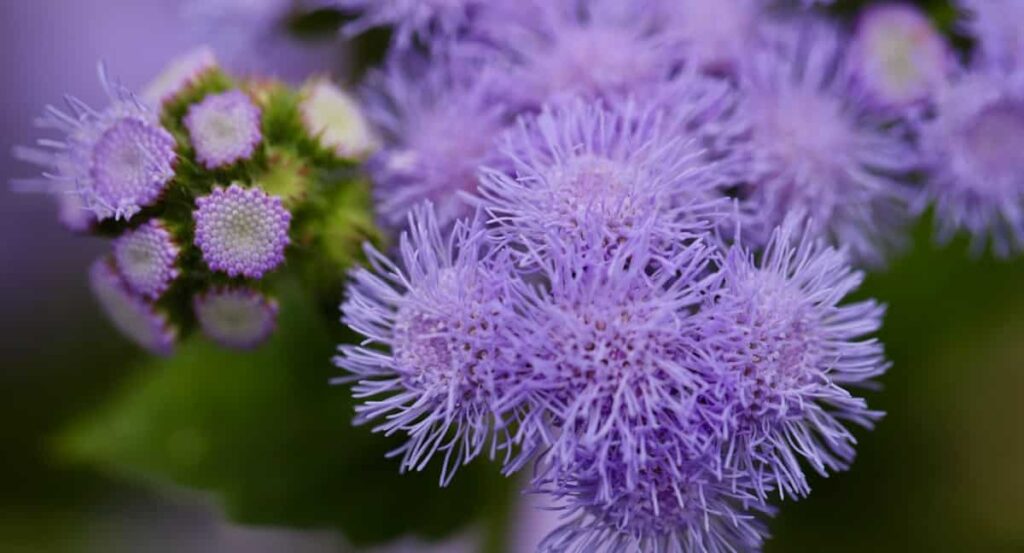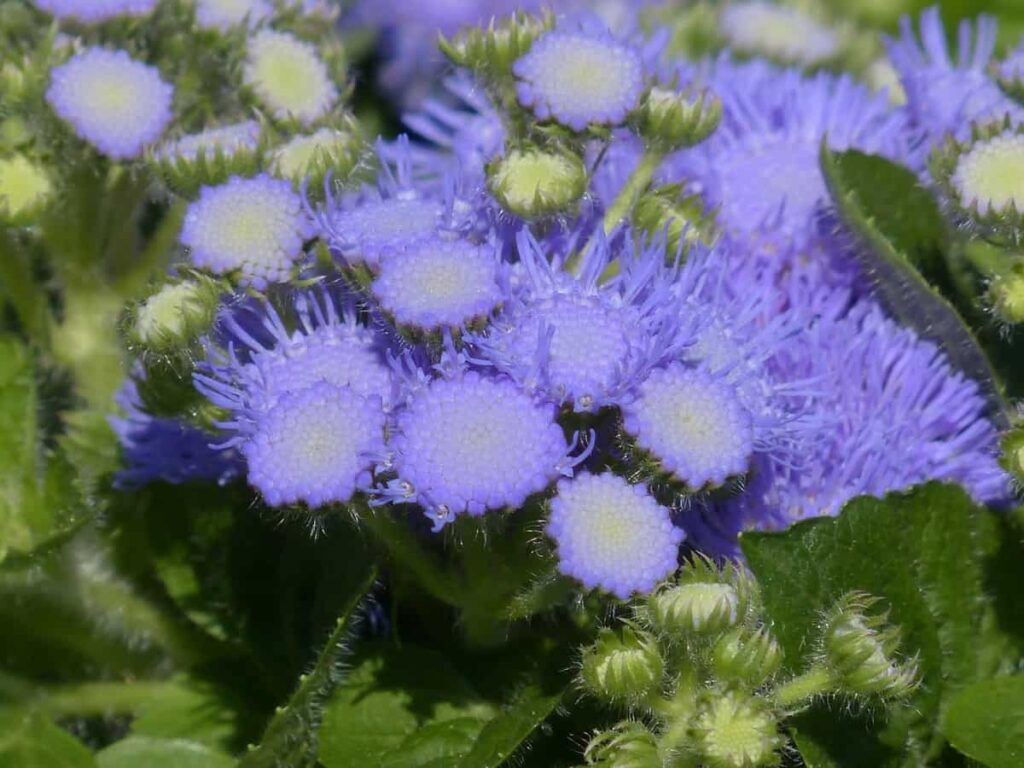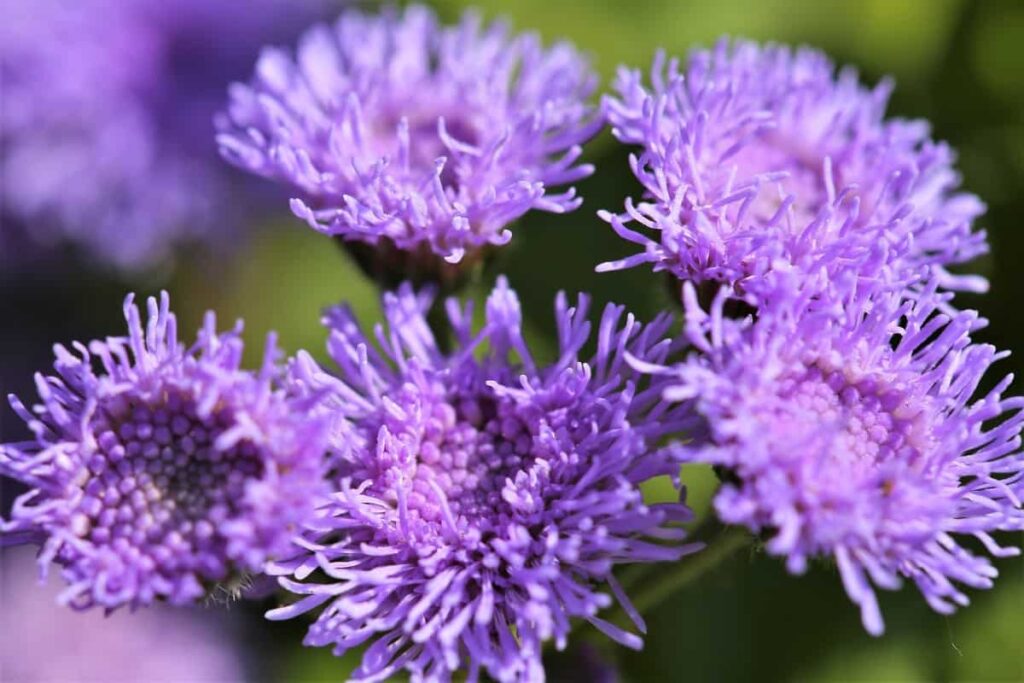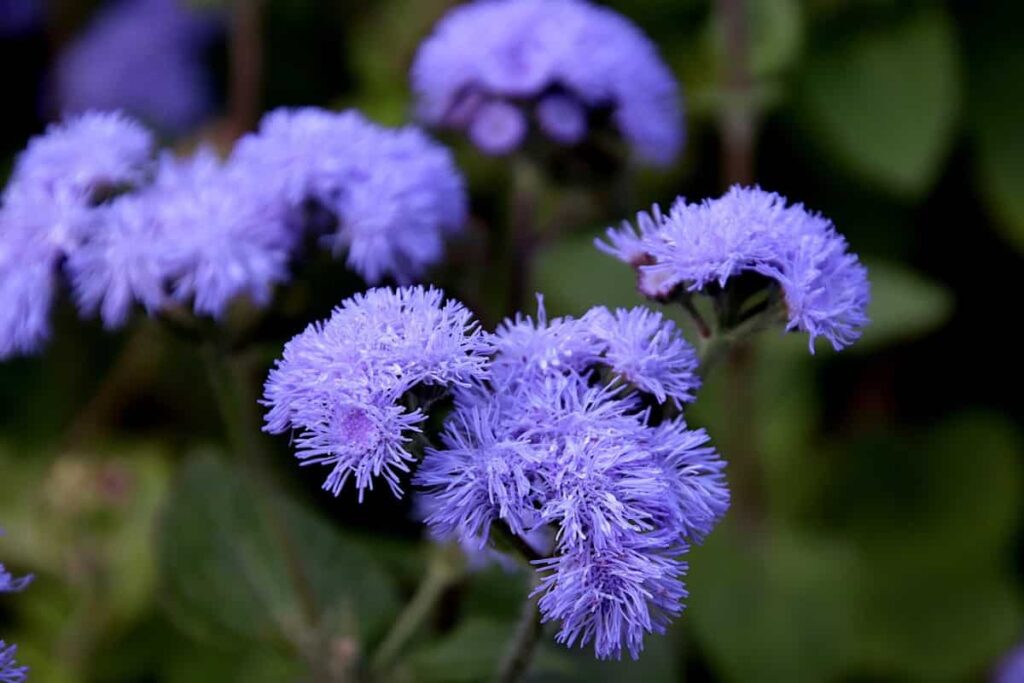The Ageratum plant grows to 12 to 24 inches and has blue, lavender, or white flowers. Ageratum is an annual plant blooming season from summer to fall. They are typically easy to grow and care for, making them famous for gardens and landscaping. Ageratum plants are easy to grow and add greatly to any garden. They require little maintenance and will bloom all summer long. With a few simple tips, you can have a beautiful Ageratum plant.

How to grow and care for Ageratum plant
Types of Ageratum
- Blue mink – It is a soft-wooded, spreading plant that typically grows 12 to 24 inches tall. The leaves are opposite, ovate-lanceolate, and covered in soft hairs. The flowers are borne in clusters of 5 to 15 and are blue or violet. Flowering occurs from summer to autumn.
- Copri – It is a small, erect plant that grows to about 16 inches in height. The leaves are lanceolate, 2 to 4 inches long, and 0.8 to 1.2 inches wide. The flowers are blue or violet, with a diameter of 0.4 to 0.8 inches.
- Blue blazer – A blue blazer is a type of Ageratum plant known for its blue flowers. The blue blazer is a perennial plant that will bloom yearly.
- Blue surf – Ageratum plant comes in many different colors, but blue surf is one of the most popular. The blue surf Ageratum has beautiful blue flowers that look like they are surfing on the waves. This plant is perfect for anyone who wants to add beauty to their garden.
- Swing Pink – It is a perennial herb with blue or lavender flowers. The leaves are opposite, lanceolate, and hairy.
- Red Top – The plant has small, blue flowers that bloom from summer to fall. The leaves are lanceolate or ovate-shaped and can be either green or red. Red Top is a popular choice for gardens and landscaping because it is drought-tolerant, low-maintenance, and attractive to bees and butterflies.
In case you missed it: 13 Popular Houseplants with White Flowers: You Should Add to Your Home

Climate suitable for growing Ageratum
Ageratum plants require a warm climate to thrive. They require full sun and well-drained soil. Ageratum plants are not tolerant of frost and should be protected from the cold weather by being placed in a sheltered location. Ageratum plants require a warm climate to thrive.
They can be grown outdoors in areas that experience no frost or indoors as houseplants in cooler climates. When growing Ageratum outdoors, select a location with full sun to partial shade. If you are growing Ageratum indoors, place it near a bright window. Outdoors, Ageratum does best in an area with 6 hours of direct sunlight daily.
Soil requirement for growing Ageratum
Ageratum plants are native to tropical regions and thrive in moist, well-drained soils. They prefer soil with a high organic matter content and do best in full sun to partial shade. Ageratum plants are not drought tolerant and will wilt quickly if the soil dries out. You should keep the soil evenly moist throughout the growing season. You should apply mulch around the base of the plant to help retain moisture in the soil.
Ageratum plants are not particularly fussy regarding soil requirements but prefer well-drained soil high in organic matter. Consider amending your soil with sand or compost before planting if it is heavy or clay-like. Ageratum also prefers a slightly acidic to neutral pH level (between 6.0 and 7.0), so testing your soil and adjusting accordingly is always a good idea.
In case you missed it: 25 Flowers for Container Gardening: Top Best List and Easy for Beginners

Water requirement for growing Ageratum
The water requirement for growing Ageratum is not very high. You must water them more frequently during the blooming period to keep the soil moist. Once the flowers start to fade, you can reduce the watering frequency. They should be watered regularly, taking care not to overwater. Overly wet conditions promote fungal diseases such as powdery mildew and gray mold.
The Ageratum plant is a moisture-loving plant that does best when the soil is moist. Water your Ageratum plant deeply, but don’t allow it to sit in water. If growing Ageratum in a container, check the drainage holes to ensure they’re not blocked. Without enough water, the plants will not be able to thrive. You will need to water your Ageratum plants more frequently if you live with little rainfall. A soaker hose or drip irrigation system will help to prevent the leaves from getting wet and reduce the chances of fungal diseases.
Ageratum plant propagation
From seed
Ageratum plants are easily propagated from seed. Indoors sow Ageratum seeds about six to seven weeks before the last frost date. Use a seed-starting mix and sow the seeds on the surface of the mix. You should not cover the seeds, as they require light to germinate. Keep the seed-starting mix moist but not wet, and soon you will see Ageratum seedlings poking through the soil.
Pot size required for growing Ageratum
The pot size you need to grow Ageratum will depend on the size of the plant. Ageratum plants can range in size from 6 inches to 24 inches tall. If you are growing a smaller plant, you only need a 6-inch pot. If you are growing a larger plant, you will need a 12-inch pot. When growing Ageratum, it is essential to choose a large pot to accommodate the plant’s root system.
When choosing a pot for Ageratum, it is also essential to consider the material. Ageratum plants prefer well-drained soil, so a porous material like terracotta or plastic is ideal. These materials will help to prevent the roots from becoming waterlogged and allow excess moisture to evaporate quickly.
Transplanting Ageratum plant seedlings
You can transplant your Ageratum plants into your garden or keep them in pots when all danger of frost has passed. In warm climates, you might want to keep your Ageratum plants in pots so you can move them into partial shade if necessary. Choose a location for your transplanted Ageratum plants that has well-drained soil and receives full sun to partial shade.
In case you missed it: Top 10 All Year Flowering Plants

You can prepare the area by loosening the soil with a shovel or tiller. Dig a large enough hole to accommodate the root ball of your seedling. Gently remove the Ageratum seedling from its current container and place it in the hole. Backfill the hole with soil, and gently tamp it down as you go. Water the newly transplanted Ageratum seedlings deeply and evenly.
Ageratum plant care
Fertilizer requirement for growing Ageratum
To achieve the best growth and color, fertilize the Ageratum monthly with a balanced liquid fertilizer such as 10-10-10. If you want to grow in containers, use a water-soluble fertilizer designed for containerized plants. You should follow the directions on the fertilizer package; over-fertilizing can damage plants.
The best fertilizer for Ageratum is one that is high in phosphorus. Phosphorus helps promote root growth and flowering. You can apply a fertilizer with a ratio of 5-10-5 or 10-20-10 monthly during the growing season. Ageratum plants are typically heavy feeders and benefit from being fertilized regularly. If your plant looks yellow or sickly, you should increase the frequency of your fertilizer applications.
Pruning Ageratum plant
Pruning is an essential part of growing and caring for Ageratum plants. By pruning, you can encourage growth, control the plant’s shape, and remove any dead or damaged leaves or stems. To prune Ageratum plants, start by cutting off dead or damaged leaves or stems. Then, trim back any long or straggly branches to promote new growth. You can also shape the plant by pruning back side shoots and main stems to create a more compact shape.
Finally, cut back any flower stems that have finished blooming to encourage new flowers to grow. To keep your Ageratum plant looking its best, you must prune it regularly. Pruning helps to encourage new growth and also keeps the plant from getting too leggy. When pruning, you should use sharp, clean shears. You can prune your Ageratum plant any time of year, but late winter or early spring is ideal.
Deadheading Ageratum plant
Deadheading the Ageratum plant is simple and easy to do. Removing the spent flowers encourages the plant to produce more blooms. First, identify the spent flowers on the plant. These flowers are starting to turn brown or have already turned brown. Snip off the spent flower at its base using a sharp pair of scissors or gardening shears. Repeat this process until all of the spent flowers have been removed from the plant. Once you have finished deadheading, give your plant a good watering and fertilize it according to package directions.
In case you missed it: Cool-season Plants for Pollinators: Vegetables, Flowers, Fruits, Shrubs, and Herbs

Ageratum plant care in winter
Ageratum plants are annuals that thrive in the summer heat and produce blue, lavender, pink, or white flowers. They do not tolerate frost well, so you should be planted outside after the last frost date. Ageratum can be started from seed or purchased as transplants. If you live in freezing winters, you must bring your Ageratum plants indoors before the first frost. Please place them in a sunny window and water them when the soil is dry.
Cut back on fertilizing while indoors. When all danger of frost has passed, please bring them back outside. Bring potted Ageratum plants indoors or store them in a dark place such as a garage or basement. Water Ageratum plants sparingly during winter; they will go dormant and don’t need much water. Fertilize Ageratum plants once every few months with a balanced fertilizer; too much fertilizer can damage the plant. Check the plants regularly for pests and diseases, and treat them accordingly.
Pests and diseases of Ageratum and their control
- Aphids – Aphids can cause stunted growth, deformed leaves, and reduced flower production. To control aphids, use an insecticidal soap or neem oil solution.
- Whiteflies – Whiteflies suck the sap from plants. They can cause yellowing leaves, stunted growth, and reduced flower production. To control whiteflies, use an insecticidal soap or neem oil solution.
- Spider mites – Spider mites feed on the sap of plants. They can cause stippling on leaves, webbing between leaves and stems, and eventual leaf drop. To control spider mites, use a miticide such as dimethoate.
- Thrips – Thrips also feed on the sap of plants. They can cause stunted growth, deformed leaves, and reduced flower production. To control thrips, use an insecticidal soap.
- Diseases of Ageratum include powdery mildew and downy mildew. Powdery mildew causes white powdery spots on the plant’s leaves. Downy mildew is another fungal disease that causes gray or white fuzzy growth on the undersides of the leaves.
- The best way to control diseases of Ageratum is to prevent them from taking place in the first place. This can be done by planting in well-drained soil, avoiding overhead watering, and ensuring that the plants have adequate air circulation around them.
In case you missed it: 16 Best Outdoor Flowering Plants in India: How to Plant, Grow and Care

Conclusion
The Ageratum plant is a beautiful and unique plant that can add a lot of character to your home. The Ageratum plant is a beautiful, easy-to-grow flower that adds color and life to any garden. There are many different Ageratum plants, each with a unique appearance and care needs.
While all Ageratum plants require some basic care, such as regular watering and occasional trimming, the specific needs of each type of plant can vary. By researching and choosing the right type of Ageratum plant for your garden, you can ensure that your plant will thrive and add beauty to your space for years to come.
- Flower Garden Designs and Layouts for Beginners
- Planting and Spacing Techniques in Papaya: A Beginner’s Guide
- Growing Gold: Essential Techniques for Planting Pineapples
- How to Make Kalanchoe Plant Bushy: Home Remedies and Solutions
- 11 Reasons Why Your Gardenia is Not Blooming: Home Remedies and Solutions
- Eco Elegance: The Guide to Designing a Drought-Tolerant Landscape
- Gardening on a Slope: Strategies for Hillside Landscaping
- Nourish and Flourish: Top Organic Mulches for Thriving House Plants
- Everything You Want to Know about Indian Mogra Flower: Discover Uses and Growing
- Green Thumb Success: Expert Tips for Cultivating Greenhouse Pumpkins All Year Round
- Maximize Growth & Flavor: The Ultimate Guide to Companion Planting in Herb Gardens
- How to Control Rhododendron Problems Naturally: Home Remedies and Organic Ways to Fix Them
- Natural Magic: The Remarkable Benefits of Cinnamon for Plants
- Best Steps to Revive Dying Tulip with Natural and Organic Treatment
- 10 Reasons Why Your Angel Trumpet is Not Blooming: Remedies and Treatment
- How to Fix Periwinkle Leaf and Flower-Related Problems: Natural Remedies and Solutions
- How to Fix Zinnias Leaf and Flower Problems: Discover Natural and Home Remedies
- Organic Steps to Induce Lemon Tree Flowers: A Comprehensive Guide
- Bloom Booster: Crafting the Perfect Homemade Bougainvillea Fertilizer
- Optimizing Growth: A Guide to Applying NPK Fertilizer for Potted Plants
- 10 Best Homemade Fertilizers for Rubber Plant: DIY Recipes and Application Method
- How to Boost Female Pumpkin Flowers: Effective Steps for More Flowers and High Yields
- Transform Your Indoor Garden: Top Benefits of Pink Salt for Houseplants
- 10 Best Homemade Fertilizers for Peacock Plants (Calathea): Easy DIY Guide
- Unlock Blooms: 9 Reasons Why Your Potted Chrysanthemum is Not Blooming
- 8 Reasons Why Your Potted Hibiscus is Not Blooming: Fix it with Simple Solutions
- Unlock Blooms: 9 Key Reasons Your Potted Frangipani Won’t Flower
- 10 Reasons Why Is My Ice Plant Not Blooming: Remedies and Treatment
- 10 Reasons Why My Potted Hydrangea Not Blooming: Treatment and Remedies
- 10 Reasons Why is My Wisteria Not Blooming: Remedies and Treatment
- 10 Reasons Why is My Goldfish Plant Not Blooming: Remedies and Treatment
- Maximize Your Space: Ultimate Guide to Balcony Gardening with Grow Bags
- 10 Reasons Why Your Iris is Not Blooming: Remedies and Treatment
- 10 Reasons Why Your Anthurium Plant is Not Blooming: Treatment and Remedies
- 10 Reasons Why Your Aquaponic Plants Are Not Flowering: Remedies and Treatment
- 10 Reasons Why Your Agapanthus is Not Flowering: Remedies and Treatment
thanks these informations. but what about Ageratum conysoides ?